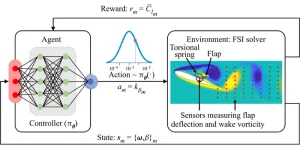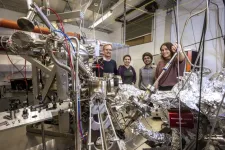(Press-News.org) There is extensive research on how a fixed-position flap affects lift in the realm of fluid-structure interaction. However, taking the conversation in a new direction, researchers at the University of Illinois Urbana-Champaign conducted a bio-inspired study with a novel twist—variable stiffness—to learn more about how it affects lift.
The researchers wondered if they could model a flap on an airfoil, or wing, with varying stiffnesses over time much like a bird can tense, or stiffen, the musculature and tendons connected to covert feathers.
“We know from previous studies that having a flap with some stiffness could help increase lift in the stall regime,” said Andres Goza, a professor in the Department of Aerospace Engineering at UIUC. “So, that begged the question: What if you could tune the stiffness? How much benefit would there be?”
The results of the study showed a big benefit. “Our flap with a variable stiffness was better than having no flap by 136 percent and 85 percent better than the best possible single stiffness flap from an earlier study we conducted.”
Goza and his student Nirmal Nair modeled a variable stiffness actuator on a flap hinged to an airfoil via a torsional spring to create a hybrid controller that changes the stiffness over time. The flap itself cannot flop or bend in any way. The stiffness refers to how tightly the torsional spring is holding onto the flap.
“In the simulation, we trained a controller that determined a specific value on the spectrum from very stiff to very loose. The controller was built using reinforcement learning, and trained to select a stiffness to improve lift on the airfoil,” Goza said.
“Using the variable stiffness actuators, we obtain the changes in stiffness values of the spring. The spring is a simplified model. In practice, this functionality can be implemented using variable stiffness actuators, though this is a non-trivial step that would require a new research effort, beyond the scope of what we looked at. The results of our tuneable stiffness paradigm were compared to the best possible single stiffness case, obtained by building a performance map for several different simulations corresponding to a single stiffness value each.”
Goza said the lift improvements are achieved due to large-amplitude flap oscillations as the stiffness varies over four orders of magnitude.
“For the first nine time units, the controller tried different stiffnesses and learned what happened,” Goza said. “Then we turned it loose for the remainder of the simulation: at a given instance in time, it decides to change the stiffness and actively adapt over time based on what the flow is doing to get a boost in lift.”
Goza said it is complicated to develop a control strategy like this one.
“As the stiffness changes, the flap moves. Then the flap motion changes the airflow around it, so there is a complex coupling going on,” Goza said. “Now the flap will respond differently to the change of the flow field around it and as the flow field changes, the response of the flap will change again. Simulating this two-way coupling is a source of complexity.
“A strength of our work is that we model all of that. We fully account for the two-way coupling between the structural motion and the response. And that’s key to developing an accurate controller. We need to be able to say, when I change the stiffness, here’s the interplay that will happen and harness that to give it a better lift.”
Goza said most often when people think about control, it’s about feedback. We receive information about a system, then use that information to make a decision. There are consequences, and you keep auto-correcting.
“This hybrid controller tunes the stiffness, but we call it hybrid because we don’t directly control the flap motion. We're just saying the flap has a specific stiffness, and I am going to actuate that and change the stiffness. Everything that happens next is based on the physics of that stiffness. The flap will feel what's happening in the flow and start deploying of its own accord. And it's going to start inducing these other dynamics.”
Goza said the most natural application for this research is unoccupied vehicles that have onboard computers.
“For these smaller aircraft, gusts can have a much larger impact,” Goza said. “They need to be more maneuverable, for example in natural disasters there may be a need to reach a location where humans can’t easily travel.”
He added that computation has utility “because you can allow the controller to vary the stiffness across 4 orders of magnitude, and whatever the resulting number is just gets used in the simulation. You’re not constrained by physical limitations. That lets us explore parameter spaces that we wouldn’t otherwise know about, and use that as a springboard to motivate clever experimentalists to realize these parameter ranges.
“At this point in the research, the structural designs that undergo the required stiffness changes don’t exist. So, in this way computation can inspire material scientists to develop new materials/structural design paradigms that can do it,” Goza said.
The study, “Bio-inspired variable-stiffness flaps for hybrid flow control, tuned via reinforcement learning,” was written by Nirmal J. Nair and Andres Goza. It is published in the Journal of Fluid Mechanics. DOI: 10.1017/jfm.2023.28
END
Model simulates variable flap stiffness for the best lift
2023-04-06
ELSE PRESS RELEASES FROM THIS DATE:
Broccoli consumption protects gut lining, reduces disease, in mice
2023-04-06
UNIVERSITY PARK, Pa. — Broccoli is known to be beneficial to our health. For example, research has shown that increased consumption of the cruciferous vegetable decreases incidences of cancer and type 2 diabetes. In a recent study, researchers at Penn State found that broccoli contains certain molecules that bind to a receptor within mice and help to protect the lining of the small intestine, thereby inhibiting the development of disease. The findings lend support to the idea that broccoli truly is a ‘superfood.’
“We ...
UNLV, SNWA study makes case for Candida auris wastewater surveillance
2023-04-06
A rapid spike in cases of a potentially deadly, drug-resistant fungus has concerned public health officials across the nation. But a team of Southern Nevada researchers hope their new study applying wastewater surveillance can help health officials get a step ahead of this emerging global public health threat.
The Pathogen Problem
Candida auris is a fungus that can cause serious infections, particularly in patients who are immunocompromised, have pre-existing health conditions, are in long-term healthcare settings, or are undergoing treatment with invasive medical devices such as a catheter. Infection prevention ...
Giving pregnant women routine third trimester ultrasound scans could reduce rates of undetected breech pregnancy by 71%, enabling better care before and during labor and improved outcomes for newborns
2023-04-06
Giving pregnant women routine third trimester ultrasound scans could reduce rates of undetected breech pregnancy by 71%, enabling better care before and during labor and improved outcomes for newborns
In your coverage, please use this URL to provide access to the freely available paper in PLOS Medicine: http://journals.plos.org/plosmedicine/article?id=10.1371/journal.pmed.1004192
Article Title: Impact of point-of-care ultrasound and routine third trimester ultrasound on undiagnosed breech presentation and perinatal outcomes: An observational multicentre cohort study
Author Countries: United Kingdom, Turkey
Funding: The author(s) received no specific funding for this work. END ...
Implant treats dangerously low blood pressure in people with spinal cord injury
2023-04-06
An implant that delivers electrical stimulation to a select group of spinal neurons can treat dangerously low blood pressure in people with spinal cord injuries, addressing an often “invisible” consequence of paralysis.
For his work in developing this treatment, called the neuroprosthetic baroreflex, Jordan W. Squair is the winner of the 2023 BioInnovation Institute & Science Prize for Innovation. The prize seeks to reward scientists who deliver research at the intersection of the life sciences and entrepreneurship.
“Dr. Squair’s prize-winning research on epidural electrical stimulation restores blood pressure control in patients ...
Editorial: Share SARS-CoV-2 data immediately
2023-04-06
In an editorial, Maria Van Kerkhove – who serves as the technical lead for the COVID-19 response at the World Health Organization (WHO) – outlines how earlier this month (March 2023), WHO learned that scientists in China possessed data on viral samples from Wuhan that had been gathered in January 2020. “These should have been shared immediately—not 3 years later,” she writes. “The lack of data disclosure is simply inexcusable.” WHO continues to call on China and all countries to share any data on the origins of SARS-CoV-2 immediately. “China has advanced technical capabilities,” Van ...
Uncovered: A new mode of reproduction that produces chimeric males in yellow crazy ants
2023-04-06
Male yellow crazy ants (Anoplolepis gracilipes) are chimeras of two separate genetic lineages, researchers report in a study that reveals a unique mode of reproduction in this species – one previously unknown to science. While most multicellular organisms develop from a single-cell zygote into a collection of genetically identical cells – a hallmark of biological inheritance – the new findings show that yellow crazy ants deviate from this expectation. According to the study, all male yellow crazy ants are instead composed ...
Bushmeat consumption unchanged by COVID-19 in Kenya and Tanzania border towns, new study reveals
2023-04-06
First ever study looking at disease risks of wild meat activities in rural communities.
Nearly 70% of rural respondents at Kenya-Tanzania border said that COVID-19 did not impact their levels of wild meat consumption, with some even reporting increased consumption.
Ungulates were found to be the most consumed species, followed by birds, rodents and shrews.
Governments need to focus on better controlling zoonotic disease transmission risks through community engagements on behavior change interventions, improving hygiene and standards of informal markets, supporting wildlife conservation ...
Methyl groups enhance key properties of PHA plastics and enable closed-loop recyclability
2023-04-06
A class of polyesters considered a promising alternative to common plastics, were it not for limitations like brittleness and thermal instability, have now been made more mechanically tough and thermally stable. Researchers replaced the reactive hydrogens in the monomer of these materials – polyhydroxyalkanoate (PHA) plastics – and found it enhanced PHA thermal and mechanical properties and enabled closed-loop chemical recyclability. The new approach could provide a route for increased use of sustainable PHA plastics. ...
Ultra-fast light at the end of the vacuum tunnel: Meta-optics shows physical processes in the attosecond range
2023-04-06
Developed at Harvard, and successfully tested at Graz University of Technology (TU Graz), a revolutionary new meta-optics for microscopes with extremely high spatial and temporal resolution has proven its functional ability in laboratory tests at the Institute of Experimental Physics at TU Graz. Microscopes using this kind of lens promise completely new research and development approaches, especially in semiconductor and solar cell technology. The research team from Graz and Boston currently reports on the construction and the successful laboratory experiment with this new meta-optics in the specialist journal Science.
The lens of ...
New atomic-scale understanding of catalysis could unlock massive energy savings
2023-04-06
MADISON – In an advance they consider a breakthrough in computational chemistry research, University of Wisconsin–Madison chemical engineers have developed model of how catalytic reactions work at the atomic scale. This understanding could allow engineers and chemists to develop more efficient catalysts and tune industrial processes — potentially with enormous energy savings, given that 90% of the products we encounter in our lives are produced, at least partially, via catalysis.
Catalyst materials accelerate chemical reactions without undergoing changes themselves. ...




